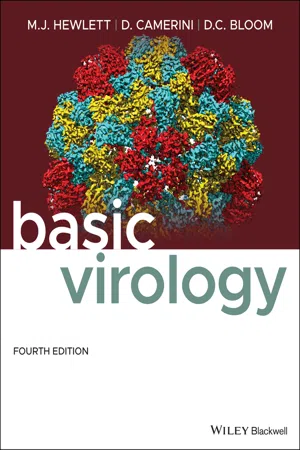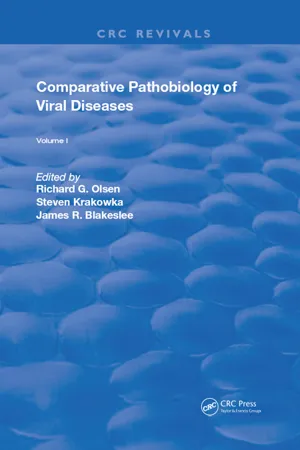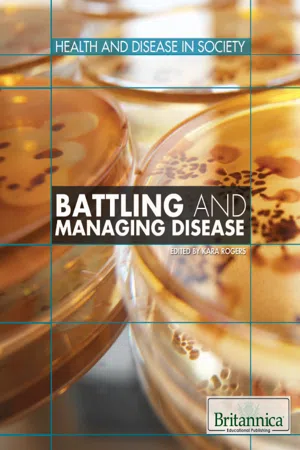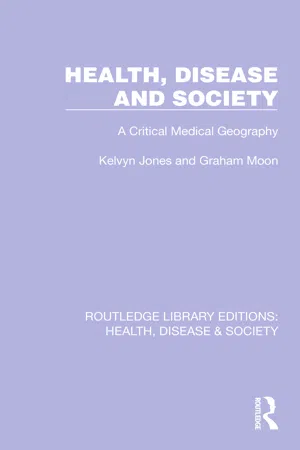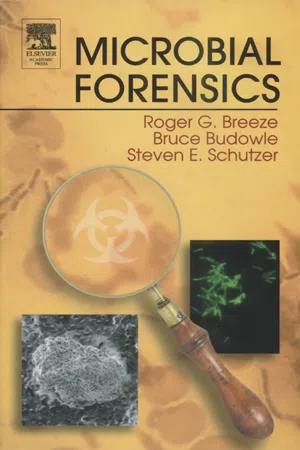Biological Sciences
Viral Diseases
Viral diseases are caused by viruses that infect living organisms, including humans, animals, and plants. These diseases can range from mild, such as the common cold, to severe, such as Ebola and HIV. Viruses can spread rapidly and cause epidemics or pandemics, making them a significant public health concern.
Written by Perlego with AI-assistance
Related key terms
6 Key excerpts on "Viral Diseases"
- eBook - ePub
- Martinez J. Hewlett, David Camerini, David C. Bloom(Authors)
- 2021(Publication Date)
- Wiley-Blackwell(Publisher)
The whole development of molecular biology and molecular genetics is largely based on the deliberate choice of some insightful pioneers of “pure” biological research to study the replication and genetics of viruses that replicate in bacteria: the bacteriophages. (Such researchers include Max Delbrück, Salvadore Luria, Joshua Lederberg, Gunther Stent, Seymour Benzer, André Lwoff, François Jacob, Jacques Monod, and many others.)The bacterial viruses (bacteriophages) were discovered through their ability to destroy human enteric bacteria such as Escherichia coli, but they had no clear relevance to human disease. It is only in retrospect that the grand unity of biological processes, from the simplest to the most complex, can be seen as mirrored in replication of viruses and the cells they infect.The biological insights offered by the study of viruses have led to important developments in biomedical technology and promise to lead to even more dramatic developments and tools. For example, when infecting an individual, viruses target specific tissues. The resulting specific signs and symptoms, as already noted, define their pathogenicity. The normal human, like all vertebrates, can mount a defined and profound response to virus infections. This response often leads to partial or complete immunity to reinfection. The study of these processes was instrumental to gaining an increasingly clear understanding of the immune response and the precise molecular nature of cell–cell signaling pathways. It also provided therapeutic and preventive strategies against specific virus‐caused disease. The study of virology has and will continue to provide strategies for the palliative treatment of metabolic and genetic diseases not only in humans, but also in other economically and aesthetically important animal and plant populations.Examples of the impact of viral disease on human history
There is archeological evidence in Egyptian mummies and medical texts of readily identifiable viral infections, including genital papillomas (warts) and poliomyelitis. There are also somewhat imperfect historical records of viral disease affecting human populations in classical and medieval times. While the recent campaign to eradicate smallpox has been successful and the virus no longer exists in the human population (owing to the effectiveness of vaccines against it, the genetic stability of the virus, and a well‐orchestrated political and social effort to carry out the eradication), the disease periodically wreaked havoc and had profound effects on human history over thousands of years. Smallpox epidemics during the Middle Ages and later in Europe resulted in significant population losses as well as major changes in the economic, religious, political, and social life of individuals. Although the effectiveness of vaccination strategies gradually led to decline of the disease in Europe and North America, smallpox continued to cause massive mortality and disruption in other parts of the world until after World War II. Despite smallpox being eradicated from the environment, the attack of September 11, 2001, on the World Trade Center in New York has led some government officials to be concerned that the high virulence of the virus and its mode of spread might make it an attractive agent for bioterrorism - eBook - ePub
- Jane Flint, Vincent R. Racaniello, Glenn F. Rall, Theodora Hatziioannou, Anna Marie Skalka(Authors)
- 2020(Publication Date)
- ASM Press(Publisher)
When these defenses are compromised, even the most common infection can be lethal. Despite such defenses, some of the most devastating human diseases have been or still are caused by viruses; these diseases include smallpox, yellow fever, poliomyelitis, influenza, measles, and AIDS. Viral infections can lead to life-threatening diseases that impact virtually all organs, including the lungs, liver, central nervous system, and intestines. Viruses are responsible for approximately 15% of the human cancer burden, and viral infections of the respiratory and gastrointestinal tracts kill millions of children in the developing world each year. As summarized in Volume II, Appendix, there is no question about the biomedical importance of these agents. Viruses Can Be Beneficial Despite the appalling statistics from human and agricultural epidemics, it is important to realize that viruses can also be beneficial. Such benefit can be seen most clearly in the marine ecosystem, where virus particles are the most abundant biological entities (Box 1.1). Indeed, they comprise 94% of all nucleic acid-containing particles in the oceans and are 15 times more abundant than Bacteria and Archaea. Viral infections in the ocean kill 20 to 40% of marine microbes daily, converting these living organisms into particulate matter. In so doing they release essential nutrients that supply phytoplankton at the bottom of the ocean’s food chain, as well as carbon dioxide and other gases that affect the climate of the earth. Pathogens can also influence one another: infection by one virus can have an ameliorating effect on the pathogenesis of a second virus or even bacteria. For example, mice latently infected with some murine herpesviruses are resistant to infection with the bacterial pathogens Listeria monocytogenes and Yersinia pestis - eBook - ePub
- Richard G. Olsen, Steven Krakowka, James R. Blakeslee, Jr.(Authors)
- 2019(Publication Date)
- CRC Press(Publisher)
Chapter 1 *PATHOLOGY OF Viral Diseases: GENERAL CONCEPTS
Steven Krakowka
TABLE OF CONTENTSI. Introduction A. General Features of Acute Viral Diseases B. General Features of Chronic Viral Diseases II. Virus-Induced Host Cell Damage at the Cellular Level A. Lytic Infection B. Persistent Infection C. Transformation Infection III. Types of Tissue Responses to Viral Damage and Injury A. Structural Changes in Cells Directly Attributable to Virus Replication B. Local and Systemic Tissue Damage Attributable to Inflammatory Responses to Viral Infection IV. Conclusions References I. INTRODUCTION
Recognition and delineation of the virus-specific etiologies of disease is a science that has now come of age. Lesions formerly attributable to bacterial infection, metabolic disorders, and/or inherited defects are now known to be due to viruses. However, there are very few lesions, either grossly or microsopically that can be definitely attributed to a single viral agent. Rather, general patterns of injury are recognizable. These patterns of injury, with study, have been delineated for certain groups of viruses and certain types of host/virus interactions. For descriptive purposes, a viral infection can be viewed as occurring in one of two general forms: an acute form in which the course of disease is limited in time and space, and a chronic form in which the viral disease process and host/virus interaction tend to occur over a long period of time.A. General Features of Acute Viral Diseases
Though not invariably true, acute Viral Diseases tend to be accompanied by florid but short term (2 to 3 weeks) virus replication cycles in tissues whereas the chronic or persistent viral infections tend to have low (or difficult to detect) amounts of infectious virus in tissues. Further, chronic forms of viral disease tend to be dominated by antiviral immune responses and/or host tissue proliferation. - eBook - ePub
- Britannica Educational Publishing, Kara Rogers(Authors)
- 2010(Publication Date)
- Britannica Educational Publishing(Publisher)
Viruses may survive for some time in the soil, in water, or in milk, but they cannot multiply unless they invade or parasitize living cells. Certain viruses proliferate within the host cells and accumulate in sufficient number to cause rupture and death of the cells. Others multiply within the cell body and compete with the host for nutrition or vital constituents of the cell’s metabolism. Both types of viruses are said to be cytotoxic.Most viral infections occur in childhood. This age distribution has been explained on immunologic grounds. Viruses usually induce a firm and enduring immunity. On first exposure to a virus, children may or may not contract the disease, depending on their resistance, the size of the infective dose of virus, and many other variables. Those who contract the disease, as well as those who resist the infection, develop a permanent immunity to any further exposure. By either pathway, as children grow older they progressively gather protection against viral infections. Consequently, the incidence of these infections falls in adulthood and later life. The frequency of common colds is explained on the grounds that a host of different viral agents all induce similar respiratory infections, and while a single attack confers immunity against the specific causative agent, it provides no protection against the rest.Viral Diseases cannot be treated with antimicrobial agents. This point is made because of a distressing tendency among individuals to take penicillin or another antibiotic for a common cold. Although no cure is available for most viral infections, prevention of infection through the administration of vaccines has proven valuable in reducing the incidence of certain Viral Diseases, including polio and measles. In addition, antiviral drugs have been developed to reduce the severity of symptoms associated with some viral infections, particularly those involving influenza or HIV.BACTERIAL DISEASESThe diseases produced by bacteria are the most common of infectious biotic diseases. They range from trivial skin infections to such devastating disorders as bubonic plague and tuberculosis. Various types of pneumonia; infections of the cerebrospinal fluid (meningitis), the liver, and the kidneys; and the sexually transmitted diseases syphilis and gonorrhea are all forms of bacterial infection. - eBook - ePub
Health, Disease and Society
A Critical Medical Geography
- Kelvyn Jones, Graham Moon(Authors)
- 2022(Publication Date)
- Routledge(Publisher)
This chapter is concerned with diseases that are capable of being transmitted from someone who is infected (the host) to someone who has not yet had the disease (the susceptible); they are variously known as contagious, infectious and communicable diseases. In the industrialised countries, despite the recent threat of AIDS, they are generally of low importance; even in childhood, communicable diseases are a minor cause of suffering and morbidity and now cause less than 5 per cent of all childhood deaths in Britain. Historically, they have been of much greater importance; only forty years ago tuberculosis was the disease of civilisation, and in the economically backward countries they remain the major killers today. Communicable diseases are given a separate chapter here because of this worldwide importance (two-thirds of all human illness is attributed to such causes), and because their fundamentally different disease processes, when compared to chronic and degenerative diseases, require different modes of analysis. The discussion begins with a brief introduction to the biology of the diseases and then the different research traditions of ‘disease ecology’ and ‘diffusion’ studies are outlined and illustrated. As the discussion proceeds we move away from the biomedical model towards a social, and arguably deeper, understanding of communicable diseases.The biology of infectious diseases
Communicable diseases have a bewildering diversity and it is wise at the outset to offer a classification. It is possible to produce a classification on a number of criteria (for example, portal of entry and exit of infectious agent) but a classification based on the various types of organisms and their differing means of transmission is most appropriate for our purposes.Organisms
There are six basic groups of organisms (Open University, 1985b ).- Viruses are chains of nucleic acid surrounded by a protein coat; they cannot reproduce themselves without entering the cells of plants or animals. They produce such diseases as influenza, measles (rubella), rabies, herpes, smallpox, encephalitis, yellow fever, dengue fever and German measles.
- Bacteria are true cells but have no nucleus. One example is tetanus which secretes a toxin which is taken up by the nerve endings and disrupts the nerves to the spinal cord and the brain, thereby producing an intense muscular spasm; hence the term ‘lockjaw’. Other bacterial diseases include diphtheria, pneumonia, sinusitis, botulism, gonorrhoea, typhoid, cholera, whooping cough (pertussis), yaws, syphilis and dental caries.
- Fungi produce diseases such as ‘thrush’ which results in an intense itching in the vagina, and ringworm, a skin disease which is most prevalent among children.
- Protozoa are single-celled organisms which are able to change their shape and are generally bigger than bacteria. Plasmodia produce malaria, while Trypanasoma results in sleeping sickness which currently affects an estimated 40 million people.
- Insects such as ticks and mites are multicellular organisms.
- Helminths are also multicellular organisms and they often have a complicated lifecycle. Examples include hookworms, which attack the wall of the intestine and feed off blood, thereby producing anaemia in the host, and the Ascaris
- eBook - ePub
- Bruce Budowle, Steven E. Schutzer, Roger G. Breeze(Authors)
- 2005(Publication Date)
- Academic Press(Publisher)
CHAPTER 2Infectious Diseases: Not Just a Health Matter Anymore
ROGER G. BREEZE, Centaur Science Group, Washington, DC, USAPublisher Summary
This chapter focuses on the development of preparations for uncommon infectious diseases. Biological agents developed as weapons pose different threats than naturally occurring diseases. Nation states, organized groups, and individuals are aware about the irrevocable damage caused by such diseases. The intelligence community and the Departments of Homeland Security, Justice, and State have joined the traditional agencies—Agriculture, Defense, and Health and Human Services (HHS)—as significant players in studies of infectious diseases of humans, animals, and plants. Biological warfare—the use of disease-spreading microorganisms, toxins, and pests against enemy armed forces or civilians—as historically intended or conducted by nation states for military purposes, generally focused on infectious but noncontagious agents. The goal of health professionals is to identify the properties of the virus and host that can be useful for diagnosis, treatment, and prevention. The biological community needs specific new tools to achieve a balance between adequately monitoring certain biological agents and toxins and not obstructing legitimate research and development involving those agents and toxins. Advisable steps in this direction are: a reappraisal of the biological agents, a proper Bio-security Risk Assessment starting with a definition of the facility’s biological inventory and evaluating the consequences of its loss: a step that enables the pathogens to be prioritized based on those consequences. The volume elaborates upon the needs of Federal Bureau of Investigation (FBI) specifying the usage of biological information with other evidence to investigate and correctly attribute and prosecute criminal activity, and the standards that courts will demand for the scientific evidence.
Index pages curate the most relevant extracts from our library of academic textbooks. They’ve been created using an in-house natural language model (NLM), each adding context and meaning to key research topics.
